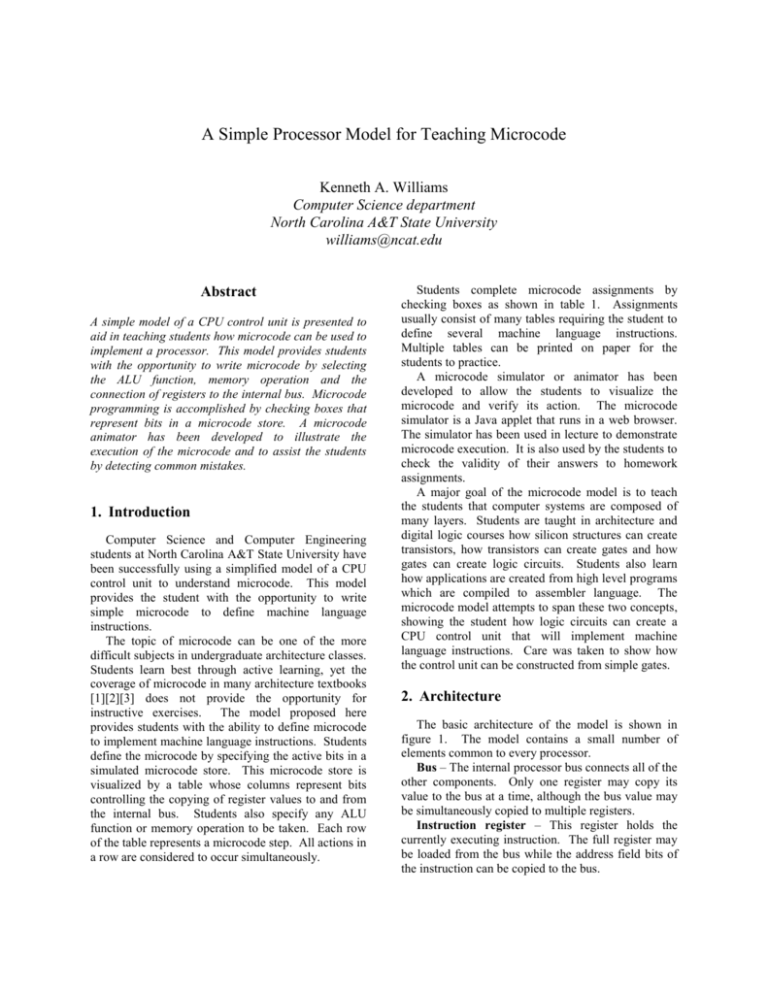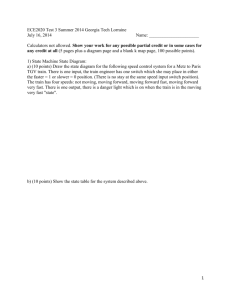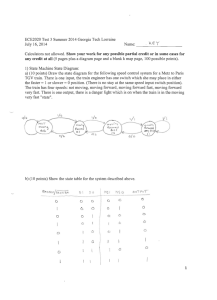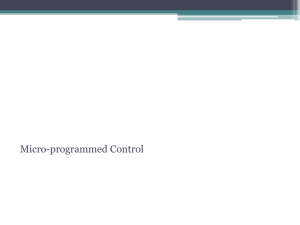
A Simple Processor Model for Teaching Microcode
Kenneth A. Williams
Computer Science department
North Carolina A&T State University
williams@ncat.edu
Abstract
A simple model of a CPU control unit is presented to
aid in teaching students how microcode can be used to
implement a processor. This model provides students
with the opportunity to write microcode by selecting
the ALU function, memory operation and the
connection of registers to the internal bus. Microcode
programming is accomplished by checking boxes that
represent bits in a microcode store. A microcode
animator has been developed to illustrate the
execution of the microcode and to assist the students
by detecting common mistakes.
1. Introduction
Computer Science and Computer Engineering
students at North Carolina A&T State University have
been successfully using a simplified model of a CPU
control unit to understand microcode. This model
provides the student with the opportunity to write
simple microcode to define machine language
instructions.
The topic of microcode can be one of the more
difficult subjects in undergraduate architecture classes.
Students learn best through active learning, yet the
coverage of microcode in many architecture textbooks
[1][2][3] does not provide the opportunity for
instructive exercises. The model proposed here
provides students with the ability to define microcode
to implement machine language instructions. Students
define the microcode by specifying the active bits in a
simulated microcode store. This microcode store is
visualized by a table whose columns represent bits
controlling the copying of register values to and from
the internal bus. Students also specify any ALU
function or memory operation to be taken. Each row
of the table represents a microcode step. All actions in
a row are considered to occur simultaneously.
Students complete microcode assignments by
checking boxes as shown in table 1. Assignments
usually consist of many tables requiring the student to
define several machine language instructions.
Multiple tables can be printed on paper for the
students to practice.
A microcode simulator or animator has been
developed to allow the students to visualize the
microcode and verify its action. The microcode
simulator is a Java applet that runs in a web browser.
The simulator has been used in lecture to demonstrate
microcode execution. It is also used by the students to
check the validity of their answers to homework
assignments.
A major goal of the microcode model is to teach
the students that computer systems are composed of
many layers. Students are taught in architecture and
digital logic courses how silicon structures can create
transistors, how transistors can create gates and how
gates can create logic circuits. Students also learn
how applications are created from high level programs
which are compiled to assembler language. The
microcode model attempts to span these two concepts,
showing the student how logic circuits can create a
CPU control unit that will implement machine
language instructions. Care was taken to show how
the control unit can be constructed from simple gates.
2. Architecture
The basic architecture of the model is shown in
figure 1. The model contains a small number of
elements common to every processor.
Bus – The internal processor bus connects all of the
other components. Only one register may copy its
value to the bus at a time, although the bus value may
be simultaneously copied to multiple registers.
Instruction register – This register holds the
currently executing instruction. The full register may
be loaded from the bus while the address field bits of
the instruction can be copied to the bus.
Figure 1 – Simple CPU model
Table 1 – Microcode for subtract R1, memory[R2] instruction
bus
IR
1
2
3
4
5
6
7
8
9
IRadr
bus
result
bus
bus
ALU
bus
op
bus
PC
X
PC
bus
bus
R1
R1
bus
bus
R2
R2
bus
X
X
bus
MAR
bus
MBR
MBR
bus
X
ALU
func
Mem
func
inc
read
wait
X
X
X
X
X
X
X
add
X
X
X
X
X
read
wait
X
X
sub
X
Program counter – This register always contains
the address of the next instruction to be executed.
User registers – Two user registers are used in the
model. The microcode provides separate controls to
load and store these registers.
ALU – The Arithmetic Logic Unit performs all
arithmetic and logic functions. Since the microcode is
usually independent of the exact arithmetic or logic
function executed, the simulator supports only add,
subtract, increment and decrement. The ALU input
for increment and decrement come from the bus while
the second operand for other arithmetic functions
comes from the operand register. The result of any
ALU operation is stored in the result register.
Operand register – This register provides input to
the ALU for arithmetic functions that require two
operands. It must be loaded previous to executing a
function in the ALU.
Result register – This register receives the results
of any ALU calculation.
Memory Address Register – The memory address
register (MAR) must be loaded with the address of any
memory location that is to be read or written.
Memory Buffer Register – Any value read from
memory will appear in the memory data register
(MBR). The MBR must be loaded with a value to be
written to memory.
The microcode store is represented by a table with
sixteen columns. The first fourteen columns control
the connection of the registers to and from the bus.
The last two columns define the ALU function and the
memory operation to be performed. A row of the
microcode table represents a single step of the
microcode program. Students create a microcode
program by putting an “X” in the boxes of the table
indicating that that bit of the microcode store is true.
A true bit will cause the value of a register to be
copied to or from the internal bus during that
microcode step. If the box is unmarked, the switch for
that column is open and no value is transferred for that
register.
In the model, the ALU performs all arithmetic,
including any arithmetic needed to calculate an
effective address. When required, the ALU function
can be set to add, subtract, increment or decrement.
The switch copying the bus value to the ALU must be
set to true when any ALU operation is performed. For
simplicity, all ALU operations are assumed to
complete in one microcode step.
The interface to the system RAM is through the
memory address register and memory buffer register.
To read data or an instruction from memory, the
memory address must be placed in the MAR and the
memory control set to read. To write data, the address
must be copied to the MAR, the data to the MBR and
the memory control set to write. Memory reads and
writes are assumed to be much slower than microcode
steps. The CPU must issue a memory wait before any
value read from memory is available in the MBR. The
memory wait function stops the execution of
microcode steps until the previous memory operation
is complete. Memory operations are assumed to occur
at the end of a microcode step. Thus a read command
can be sent to the memory during the same microcode
step that copies the address into the MAR.
3. Microcode example
Microcode programs implement the standard fetch
execute cycle of a) fetch the instruction from memory,
b) increment the program counter, c) fetch the
operand, d) execute the operation and e) write back the
results. The instruction decode step, which is usually
included in the fetch execute cycle, is omitted because
it does not involve any microcode steps. Table 1
illustrates the microcode to implement a subtract
instruction using an index register. The first three
lines implement the instruction fetch and program
counter incrementation. Step 1 copies the address in
the program counter register to the bus, where it is
then copied into the MAR. The memory function is
set to read to get the next instruction from memory.
While the program counter address is on the bus, it is
also brought into the ALU, where it is incremented. In
step 2, the incremented address is copied from the
result register and back to the program counter. At the
end of step 2, the microcode will wait until the
previous memory operation, the read of the
instruction, is complete. The instruction is then copied
from the MBR across the bus and into the instruction
register. To compute the effective address of the
memory operand for the operand fetch, the address
field of the instruction must be added to the value in
the index register, R2. In step 4, the value in user
register R2 is copied into the operand register. In the
next step, the value of the address field of the
instruction is copied onto the bus and then brought
into the ALU to be added to the value in the operand
register. The sum is stored in the result register. This
effective address is copied to the bus in step 6 and into
the MAR. The microcode starts the read of the data
operand from memory. In step 7, the value in R1 is
copied to the operand register in preparation for the
later subtract. Before step 8 can be executed, the
microcode will have to wait for the read of the data
operand to complete. Once available, the data in the
MBR is copied to the ALU, where it is subtracted
from the R1 value in the operand register. In the final
write back step, the result is copied to register R1.
Students can check their microcode programs using
the microcode animator. As they step through a
microcode program, the activated switches change
color and form, showing where the data is flowing.
The microcode animator also checks the microcode
programs for common mistakes. Some of the mistakes
detected by the animator include copying the values of
two different registers to the bus in the same step,
copying a value from the bus without copying another
register’s value to the bus, failing to wait for a
memory operation to complete, and performing an
ALU operation without copying a value into the ALU.
Many different machine language instructions can
be implemented with the microcode model, providing
the instructor with a range of possible assignments.
Defining the microcode for an instruction ensures that
the student understands how the machine language
instruction actually works. For arithmetic instructions,
different addressing modes require different
microcode. The model can easily implement jump or
branch instructions, including function call and return.
4. Simplicity of design
Writing a microcode program for the simple CPU
model only requires that students mark an “X” in the
appropriate columns and select the necessary ALU and
memory functions. This method was chosen in
preference to a register transfer notation because of its
simplicity. Hardware definition languages have an
advantage in flexibility, power and correspondence to
real world hardware design [4]. The complexity and
requirements of syntax can distract some students
from the goal of understanding microcode-based
control units. The execution of table-based microcode
can be easily explained at the gate level. Each column
of the microcode represents a switch that connects a
register to the internal bus. Connections going from a
register to the bus are realized by a transistor switch.
A true value in a microcode column that connects the
bus to a register activates the clock input of the flipflops used to construct the register.
This microcode model omits certain features
normally found in a real system. The model does not
support microcode branching or the concept of
microcode functions. All microcode programs execute
sequentially from line to line. The two user registers
are handled individually, which hides the commonality
between instructions. Thus the microcode for an Add
to R1 machine instruction is different from the
microcode for an Add to R2 instruction. These
simplifications make it easier for the student to grasp
the concept of microcode before moving on to more
complex systems.
5. Extensions
The CPU model is intentionally simple, allowing
the students to consider improvements and
enhancements as further topics are introduced.
Extensions often discussed in the lecture include:
Multiple registers – The model only contains two
user registers, which are accessed separately by the
microcode. The model can be easily enhanced to
include a register field in the instruction that connects
to a demultiplexor whose outputs select the specific
register to be accessed. The microcode instructions
for each register are then replaced with a single
microcode instruction that acts upon the selected
register.
Multiple busses – When instruction pipelining is
discussed, enhancements to the simple microcode
processor are considered that might support pipelining.
Because the result write back phase of the instruction
cycle often involved copying the result register to a
user register, an additional bus connecting the result
register to the user registers allows this stage to
overlap with reading the next instruction from
memory.
Separate data and instruction memory – When
pipeline hazards are discussed, the model can be
modified to provide two MAR and two MBR registers,
one for instruction memory and the other for data
memory.
Constant registers – When discussing interrupts,
the model is expanded to include registers which hold
constants such as the address of the new program
counter when an interrupt occurs.
The model assumes that microcode instructions are
always executed in sequential order from top to
bottom. At the end of a series of microcode steps that
defines a machine language instruction, the microcode
to start the fetch of the next instruction is assumed to
occur. After the students have mastered the simple
microcode model, the concept of microcode decisions
is discussed. An additional column is added to the
microcode to contain the microcode address of the
next line of microcode to be executed. In most cases,
the address is the next sequential line of microcode for
that machine language instruction. The last line of
microcode for an instruction contains the address of
the microcode step that starts an instruction fetch.
After an instruction is loaded into the instruction
register, the enhanced model branches to the
appropriate microcode statement based on the opcode.
6. Summary
The simple control unit model presented has been used
for the past six years at North Carolina A&T State
University to teach both Computer Science and
Computer Engineering students about microcode and
CPU implementation.
The learning has been
reinforced by requiring the students to define microcode in class, on assignments and on exams. The
simple introduction allows the students to concentrate
their mental efforts on the microcode and the structure
of a control unit. After using the simple model,
students can progress to more complex issues
expanding upon the basic concepts. The microcode
animator is available for public use on
http://williams.comp.ncat.edu/comp375/cpusim/Micro
Sim.htm
7. References
[1] William Stallings, Computer Organization and
Architecture: Designing for Performance, 7th ed., Pearson
Prentice Hall, 2006
[2] David Patterson and John Hennessy, Computer
Organization and Design: The Hardware/Software
Interface, 4th ed., Morgan Kaufmann, 2008
[3] Sivarama Dandamudi, Fundamentals of Computer
Organization and Design, Springer Verlag, 2003
[4] Zvonko Vranesic and Stephen Brown, “Use of HDLs in
Teaching of Computer Hardware Courses”, 30th
International Symposium on Computer Architecture, San
Diego, June 8, 2003





